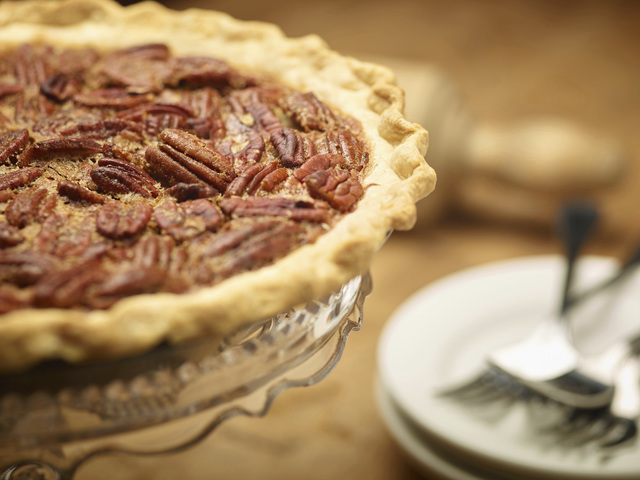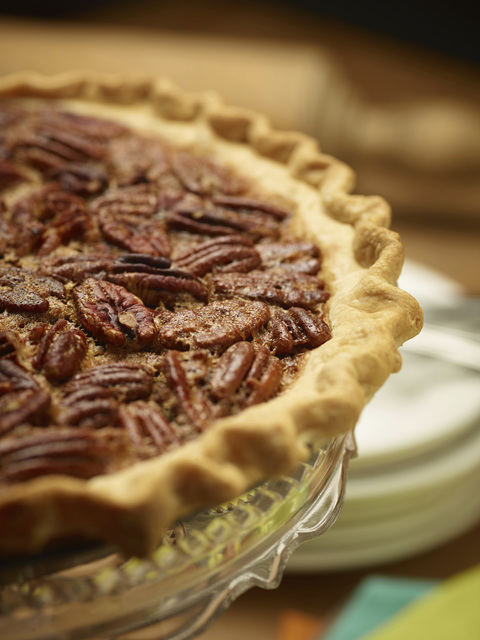When families begin to plan their Thanksgiving menus, pecan pie should always be on the list. ADVERTISING When families begin to plan their Thanksgiving menus, pecan pie should always be on the list. Pecan pie can be difficult to describe.
When families begin to plan their Thanksgiving menus, pecan pie should always be on the list.
Pecan pie can be difficult to describe. It’s not a fruit pie or a cream pie, and it’s not a traditional custard. It falls into a loosely defined category most familiar to our Southern friends — the sugar pie. Sugar pies can be found in many styles and variations, but at its roots, a sugar pie is a single-crust pie with a baked filling of sugar, eggs and flavorings.
The sugar used can be granulated sugar, brown sugar, corn syrup, maple syrup, honey or molasses, depending on what you want your standout flavors to be. Pecan pies are commonly made with corn syrup, which lends a neutral flavor that helps the nuttiness of the pecans shine through, but substituting maple syrup can give richness and complexity without altering the texture.
Because the filling of sugar pies can be very soft, the pecans play an important textural role. These nuts can be added whole, chopped or a combination of both. They will soak up some of the filling, which will make them tender enough to cut with a fork, but with enough bite to contrast the soft, creamy filling. And what are rich pecans and a sweet filling without a flaky, buttery pie crust? Our all-butter crust is partially baked before filling, which helps keep it crisp despite the wet interior. Experiment with decorative borders and crimping to make your pie stand out on a crowded table.
Pecan pies are simple to prepare (easy as pie!), but it can be tough to determine when your pie is done. Sugar pie fillings won’t always look perfectly firm when they are still hot in the oven. You will notice that the edges of the filling, just along the crust, will be a little bit puffy — like a soufflé — even when the interior still appears slightly wet and jiggly. This is a good indicator that your pie is ready.
Pecan pie
Makes one single-crusted 9-inch pie
Active time: 40 minutes. Inactive time: 1 1/2 hours to overnight.
1 recipe single-crust pie dough
1 1/2 cups toasted pecan halves
1/2 cup tightly packed light brown sugar
2 tablespoons all-purpose flour
3/4 cup light corn syrup
3 large eggs, lightly beaten
4 tablespoons (1?2 stick) unsalted butter, melted and cooled
2 teaspoons vanilla extract
1/4 teaspoon salt
Preheat the oven to 400 degrees. Roll out the pie dough and use it to line a 9-inch pie. Partially blind bake the crust. Let cool to room temperature in the pan on a rack before filling. Keep the oven temperature at 400 degrees.
Spread the nuts in an even layer over the bottom of the partially baked pie shell. Stir the brown sugar and flour together in a mixing bowl until well blended. Add the corn syrup, eggs, butter, vanilla extract and salt and blend well. Pour the mixture over the nuts, disturbing the nuts as little as possible.
Place the pie on a baking sheet and bake until the center is softly set, 30-35 minutes. Let the pie rest for at least 20 minutes before slicing. Serve warm or at room temperature.
All butter pie crust
An all-purpose buttery and flaky pie pastry made with all butter. The key to the flakiness is threefold — the size of the butter pieces; the proper mixing of the dough, which prevents the fat from completely blending into the flour; and keeping the butter cold throughout mixing. Makes two 11-inch rounds.
3 cups all-purpose flour
1 teaspoon salt
1 teaspoon granulated sugar
11 tablespoons unsalted butter, cold, cut into 3/4-inch cubes
1/2 cup water, ice cold, more as needed
To make by hand:
Combine the flour, salt, and sugar in a large bowl and scatter the butter pieces over the dry ingredients.
Using a pastry blender, or, rubbing the mixture between your fingers, work quickly to cut or rub the butter into the dry ingredients until it is in pieces the size of small hazelnuts.
Sprinkle half the ice-cold water over the butter mixture. Using your hands or a rubber spatula, lightly toss the dry mixture until the dough just begins to hold together. Continue to add water in small amounts until it becomes a rough but pliable dough. The dough should just hold together when pressed to the side of the bowl.
Turn the dough out onto a lightly floured work surface and divide into two portions. Shape the dough into 5- to 6-inch diameter flat, round disks and wrap them tightly in plastic wrap. Chill the dough in the refrigerator for at least 45 minutes to two hours or preferably overnight.
Nutrition information per serving: 703 calories; 353 calories from fat; 40 g fat (6 g saturated; 1 g trans fats); 138 mg cholesterol; 416 mg sodium; 80 g carbohydrate; 4 g fiber; 40 g sugar; 10 g protein.
This article was provided to The Associated Press by The Culinary Institute of America in Hyde Park, New York. This recipe also can be found in The Culinary Institute of America’s cookbooks, “Baking at Home” and “Pies and Tarts.”




